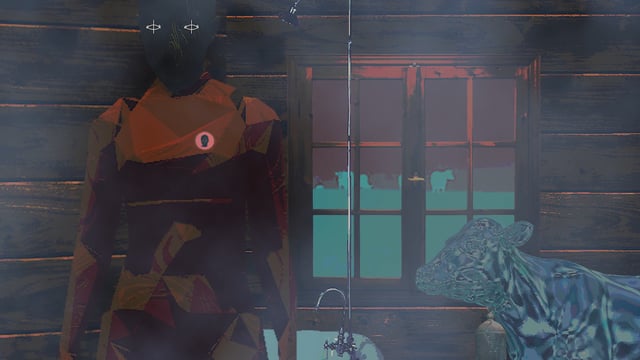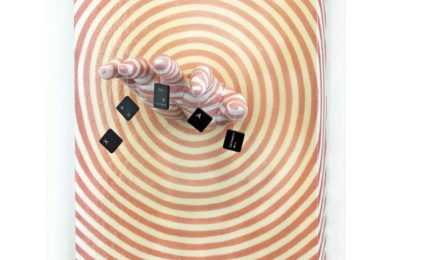Joe Reinsel uses media, video, and sound to explore ideas about architectural space, time, and touch. His creative work continues to considers interaction and the environment and each work investigates different facets of communication such as video work for public installation, collective storytelling, and interactive exhibitions. He is the recipient of grants from The Flint Public Art Project, International Society of Electronic Arts, Maryland State Arts Council, Baltimore Museum of Art, New York State Council for the Arts, New York Foundation for the Arts, Baltimore City, and University of Michigan among others. Also, he has presented work in thirteen countries on four continents at venues such as Museum of Contemporary Art (Chile), Corcoran Gallery of Art, Ars Electronica, Centro Cultural São Paulo (Brazil), Centro Cultural de España (Mexico), ZeroOne, and SIGGRAPH.
Digital America is currently featuring Joe Reisel’s It looks like Mars, as part of the Crooked Data: (Mis)information in Contemporary Art [site no longer live] exhibition at the University of Richmond Museums. You can view this piece here.
:::
DigA: Your body was scanned at the Imaging Research Center (IRC) at UMBC in Baltimore, MD. How did you learn about the capabilities of this center and its equipment? How does one prepare to be 3D scanned?
JR: The system was introduced to me through colleagues at UMBC and the IRC. After being trained to use the equipment I also thought about my reasons for doing this type of scan. My preparation for creating these images did not take an extended period and when I created the images I was in an experimental mode and trying not to understand the results. This separated me a bit from concept and design of the art work for a short period and allowed me to take a role of someone who may be running tests and then digesting the results of the output data. I am not a medical professional but these notions did come to mind doing this stage of the work.
DigA: You noted that you are more interested in the photorealistic UV texture that is placed over the 3D model, describing it as “how the computer sees” you. Can you talk a bit about why this UV texture was created and what its common purpose is? What inspired you to use it as a medium for your work?
JR: In computerized 3D modeling, there are a number of components that make up the final 3D object and making comparisons to a human body can help with understanding each one. First are the points and vectors that make up the geometry of the object and also could be thought of as the bones. Then these vectors and points are connected into surfaces and this gives a more solid appearance to the object. Then to make the object more realistic there often is a texture (UV) place around this grouping of lines, vectors and surfaces which may have color or photorealistic qualities to it. For this work, I make relationships with skin because of way that this texture is applied to the 3D object.
DigA: Did you choose how the almost 100 images came together, or are the views that we see dictated by the software?
JR: Another part of this 3D scanning system that I used is that the computer is doing many of the processing itself to create the 3D model and the UV texture. My process during these experimental stages was to turn the system on, take off my clothes stand in front of the cameras and take 96 pictures of myself simultaneously from a series of angles. The computerized system does this completely on its own. After this has completed, I then took the 3D model that was generated along with the images and then computer built a photorealistic 3D model of my body. The computer generated my position in space from the images and then used the imagery to compile a texture from then 96 still images.

DigA: Photographers have been exploring image distortion since the inception of the practice, yet the images in It looks like Mars are technically not photo distortions. As your title suggests, they are an alternate terrain. In what context do you place these images, and how you do think that context shapes the viewer’s understanding of the work?
JR: I see these images as an image but also as a terrain or surface. It is the skin of a virtually created body. One could think of the individual images from the scan as distortions, but in the context of this 3D scanning process the images are not the final results. Instead, the 96 images taken in the scanning process are data points to create the final compiled image.
DigA: Our bodies are increasingly becoming mediated by data. People wear Fitbits and other tracking devices to monitor their heart rates rather than putting a finger to their pulse. Insurance companies can subsequently track that data in order to keep costs down. Data becomes monetized the second it’s recorded. It looks like Mars can be interpreted as a caution to this growing field of data mining—the data of the body is not what it seems. What guides your interpretation of the data as it’s collected, modeled, and recast?
Joe: When I am looking at the compiled texture, I witness it more as a viewer and assessor of the artifacts that are created from the computer’s processing algorithms. Because the result is so removed from the scanning event that I did to create the images I believe I see them as a photographer may when developing an image in the darkroom. While there is a control behavior in the process there is also something that I think of as a eureka moment where I am seeing just the image and exploring the results of the process.
DigA: Much of your previous work is in video, sound, and interactive technology. In contrast, It looks like Mars is rather non-interactive. The images are unsettling and seem to resist touch. How do these images converse with your other work that is more sensory-driven?
Joe: Even though the interaction in the work is not direct and something that the audience is taking part of while viewing the work there is an interactive connection in the process. This is a step to see how the computer and software see me, the computer’s “gaze” and how it perceives me. An important element to reveal is that this conversation is not just between the computer and myself but indirectly it is connected to the software designers and how the created the software that then renders the imagery. I feel that these roles continue my ideas of working in interactive art but the roles and audience have shifted.



